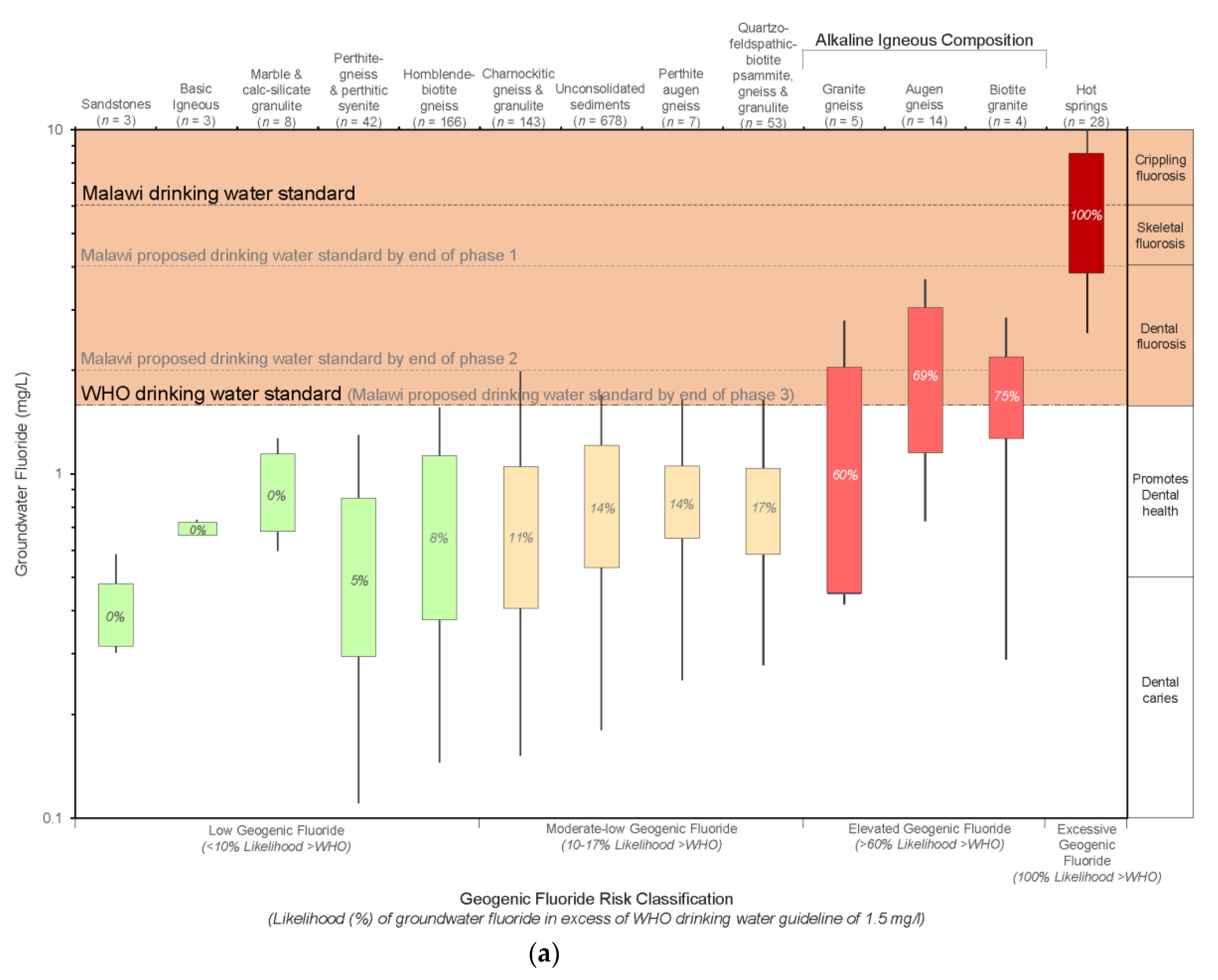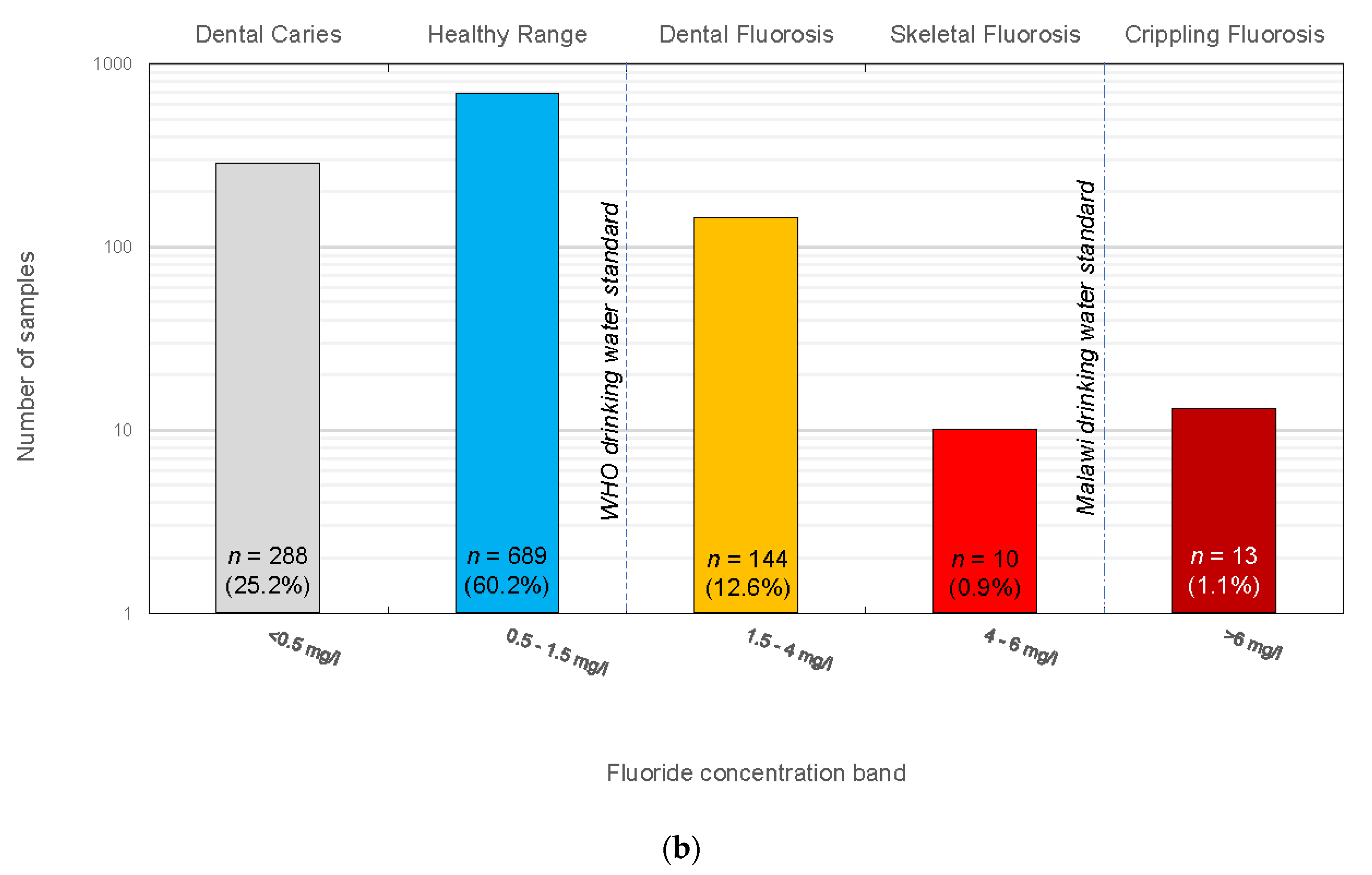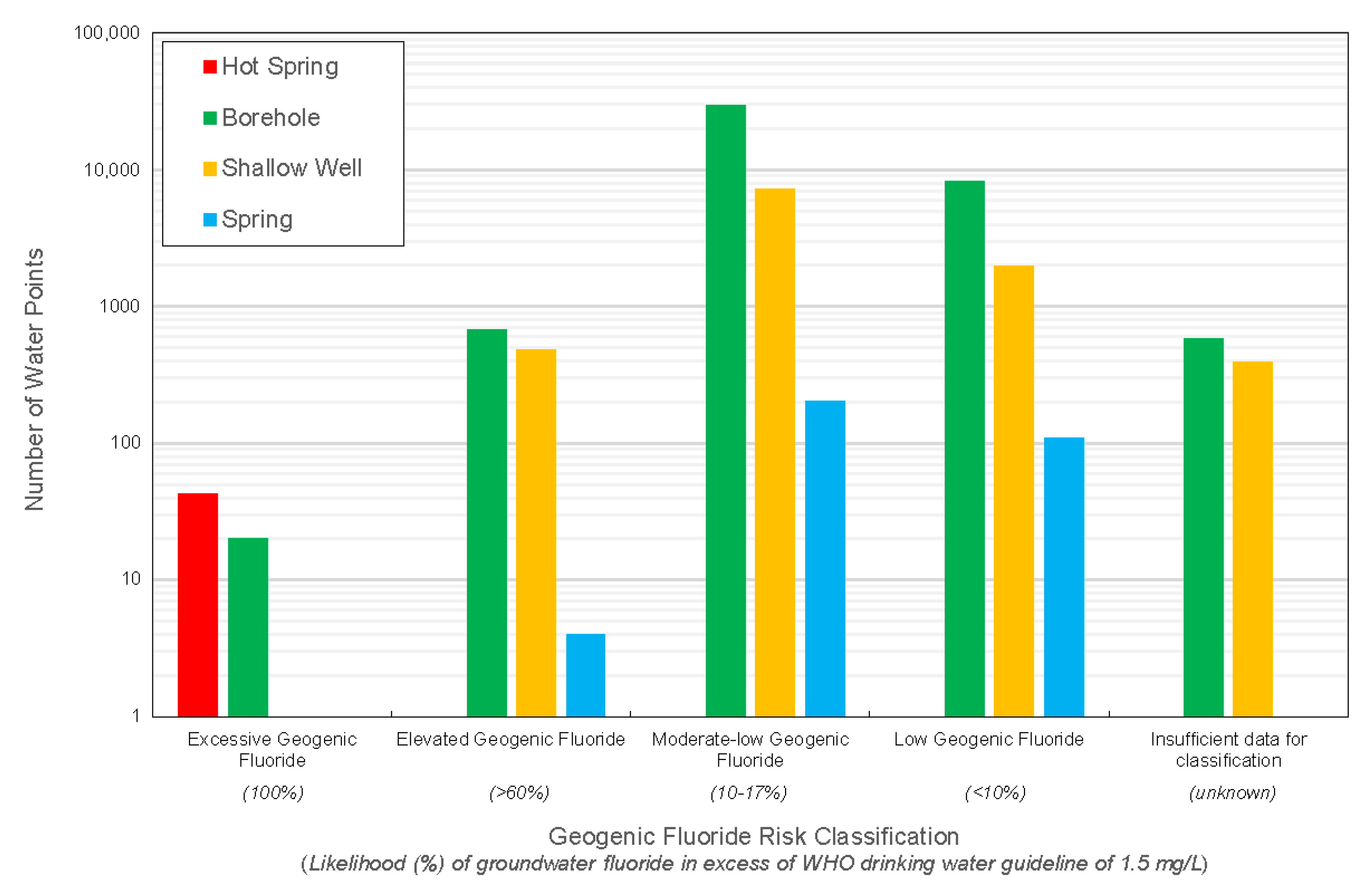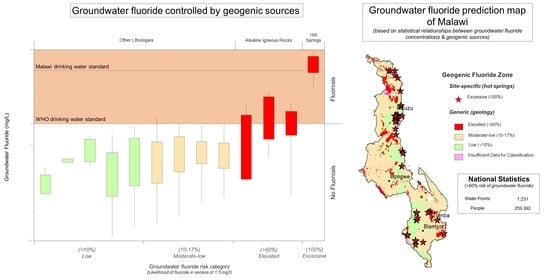Predicting Groundwater Vulnerability to Geogenic Fluoride Risk: A Screening Method for Malawi and an Opportunity for National Policy Redefinition
Abstract
:1. Introduction
2. Materials and Methods
2.1. Stage 1: Groundwater Fluoride Data Collation
2.2. Stage 2: Geological Data Collation and Digitisation
2.3. Stage 3: Development of Statistical Relationships and Extrapolations
2.4. Stage 4: Development of National Groundwater Risk Maps and Statistics
- Functional
- Partly functional but in need of repair
- Not functional
- No longer exists/abandoned
2.5. Stage 5: Policy Review and Implications
3. Results
3.1. Groundwater Data
3.2. Geological Data
3.3. Statistical Relationships and Extrapolations
3.4. National Groundwater Risk Map and Statistics
4. Discussion
4.1. Discussion of Results
4.2. Policy Review and Implications
5. Conclusions
Supplementary Materials
Author Contributions
Funding
Acknowledgments
Conflicts of Interest
References
- Upton, K.; Dochartaigh, B.É.Ó.; Chunga, B.; Bellwood-Howard, I. Africa Groundwater Atlas: Hydrogeology of Malawi. British Geological Survey. Available online: http://earthwise.bgs.ac.uk/index.php/Hydrogeology_of_Malawi (accessed on 19 October 2020).
- Kalin, R.M.; Mwanamveka, J.; Coulson, A.B.; Robertson, D.J.C.; Clark, H.; Rathjen, J.; Rivett, M.O. Stranded Assets as a Key Concept to Guide Investment Strategies for Sustainable Development Goal 6. Water 2019, 11, 702. [Google Scholar] [CrossRef] [Green Version]
- Rivett, M.O.; Budimir, L.; Mannix, N.; Miller, A.V.; Addison, M.J.; Moyo, P.; Wanangwa, G.J.; Phiri, O.L.; Songola, C.E.; Nhlema, M.; et al. Responding to salinity in a rural African alluvial valley aquifer system: To boldly go beyond the world of hand-pumped groundwater supply? Sci. Total Environ. 2018, 653, 1005–1024. [Google Scholar] [CrossRef] [PubMed] [Green Version]
- Rivett, M.; Robinson, H.; Wild, L.; Melville, J.; McGrath, L.; Phiri, P.; Flink, J.; Wanangwa, G.; Mlwta, P.; MacLeod, S.; et al. Arsenic occurrence in Malawi groundwater. J. Appl. Sci. Environ. Manag. 2018, 22, 1807. [Google Scholar] [CrossRef] [Green Version]
- Addison, M.J.; Rivett, M.O.; Robinson, H.; Fraser, A.; Miller, A.M.; Phiri, P.; Mleta, P.; Kalin, R.M. Fluoride occurrence in the lower East African Rift System, Southern Malawi. Sci. Total Environ. 2020, 712, 136260. [Google Scholar] [CrossRef] [PubMed]
- Addison, M.; Rivett, M.O.; Phiri, P.; Mleta, P.; Mbalame, E.; Kanjaye, M.; Phiri, O.; Lakudzala, W.; Kalin, R.M. Identifying Groundwater Fluoride Source in a Weathered Basement Aquifer in Central Malawi: Human Health and Policy Implications. Appl. Sci. 2020, 10, 5006. [Google Scholar] [CrossRef]
- Grimason, A.; Morse, T.; Beattie, T.K.; Masangwi, S.; Jabu, G.; Taulo, S.; Lungu, K.; Morse, T.D.; Masangwi, S.J. Classification and quality of groundwater supplies in the Lower Shire Valley, Malawi—Part 1: Physico-chemical quality of borehole water supplies in Chikhwawa, Malawi. Water SA 2013, 39, 563–572. [Google Scholar] [CrossRef] [Green Version]
- Monjerezi, M.; Ngongondo, C. Quality of Groundwater Resources in Chikhwawa, Lower Shire Valley, Malawi. Water Qual. Expos. Health 2012, 4, 39–53. [Google Scholar] [CrossRef]
- WHO; UNICEF. Progress on Drinking Water, Sanitation and Hygiene: 2017 Update and SDG Baselines; World Health Organization (WHO): Geneva, Switzerland; The United Nations Children’s Fund (UNICEF): New York, NY, USA, 2017. [Google Scholar]
- Ozsvath, D.L. Fluoride concentrations in a crystalline bedrock aquifer Marathon County, Wisconsin. Environ. Earth Sci. 2006, 50, 132–138. [Google Scholar] [CrossRef]
- Li, D.; Gao, X.; Wang, Y.; Luo, W. Diverse mechanisms drive fluoride enrichment in groundwater in two neighboring sites in northern China. Environ. Pollut. 2018, 237, 430–441. [Google Scholar] [CrossRef]
- World Health Organisation. Guidelines for Drinking-Water Quality: Fourth Edition Incorporating the First Addendum; World Health Organization: Geneva, Switzerland, 2017. [Google Scholar]
- Malawi Bureau of Standards. Borehole and Shallow Well Water—Specification; Malawi Standards Board: Blantyre, Malawi, 2005; ICS 13.060.10; MS 733:2005. [Google Scholar]
- Edmunds, W.M.; Smedley, P.M. Fluoride in natural waters. In Essentials of Medical Geology, 2nd ed.; Springer: Dordrecht, The Netherlands, 2013; pp. 311–336. [Google Scholar]
- Ghiglieri, G.; Pittalis, D.; Cerri, G.; Oggiano, G. Hydrogeology and hydrogeochemistry of an alkaline volcanic area: The NE Mt. Meru slope (East African Rift—Northern Tanzania). Hydrol. Earth Syst. Sci. 2012, 16, 529–541. [Google Scholar] [CrossRef] [Green Version]
- Nair, K.R.; Manji, F.; Gitonga, J.N. The occurrence and distribution of fluoride in groundwaters of Kenya. East Afr. Med. J. 1984, 61, 503–512. [Google Scholar]
- Tekle-Haimanot, R.; Melaku, Z.; Kloos, H.; Reimann, C.; Fantaye, W.; Zerihun, L.; Bjorvatn, K. The geographic distribution of fluoride in surface and groundwater in Ethiopia with an emphasis on the Rift Valley. Sci. Total Environ. 2006, 367, 182–190. [Google Scholar] [CrossRef]
- Msonda, K.W.M.; Masamba, W.R.L.; Fabiano, E. A study of groundwater fluoride occurrence in Nathenje, Lilongwe, Malawi. Phys. Chem. Earth 2007, 32, 1178–1184. [Google Scholar] [CrossRef]
- Pritchard, M.; Mkandawire, T.; O’Neill, J. Assessment of groundwater quality in shallow wells within the southern districts of Malawi. Phys. Chem. Earth Parts A/B/C 2008, 33, 812–823. [Google Scholar] [CrossRef]
- Sajidu, S.M.; Masumbu, F.F.F.; Fabiano, E.; Ngongondo, C. Drinking water quality and identification of fluoritic areas in Machinga, Malawi. Malawi J. Sci. Technol. 2007, 8, 42–56. [Google Scholar]
- Qasemi, M.; Afsharnia, M.; Zarei, A.; Farhang, M.; Allahdadi, M. Non-carcinogenic risk assessment to human health due to intake of fluoride in the groundwater in rural areas of Gonabad and Bajestan, Iran: A case study. Hum. Ecol. Risk Assess. Int. J. 2018, 25, 1222–1233. [Google Scholar] [CrossRef]
- Bath, A.H. Hydrochemistry in Groundwater Development: Report on an Advisory Visit to Malawi; Report No. WD/05/80/20; British Geological Survey: Nottingham, UK, 1980; pp. 29–40. [Google Scholar]
- AbdelGawad, A.; Watanabe, K.; Takeuchi, S.; Mizuno, T. The origin of fluoride-rich groundwater in Mizunami area, Japan—Mineralogy and geochemistry implications. Eng. Geol. 2009, 108, 76–85. [Google Scholar] [CrossRef]
- Berger, T.; Mathurin, F.A.; Drake, H.; Åström, M.E. Fluoride abundance and controls in fresh groundwater in Quaternary deposits and bedrock fractures in an area with fluorine-rich granitoid rocks. Sci. Total Environ. 2016, 569, 948–960. [Google Scholar] [CrossRef] [PubMed]
- Naseem, S.; Rafique, T.; Bashir, E.; Bhanger, M.I.; Laghari, A.; Usmani, T.H. Lithological influences on occurrence of high-fluoride groundwater in Nagar Parkar area, Thar Desert, Pakistan. Chemosphere 2010, 78, 1313–1321. [Google Scholar] [CrossRef]
- Chandrawanshi, C.K.; Patel, K.S. Fluoride Deposition in Central India. Environ. Monit. Assess. 1999, 55, 251–265. [Google Scholar] [CrossRef]
- Sracek, O.; Wanke, H.; Ndakunda, N.; Mihaljevič, M.; Buzek, F. Geochemistry and fluoride levels of geothermal springs in Namibia. J. Geochem. Explor. 2015, 148, 96–104. [Google Scholar] [CrossRef]
- Shitumbanuma, V.; Tembo, F.; Tembo, J.M.; Chilala, S.; Van Ranst, E. Dental fluorosis associated with drinking water from hot springs in Choma district in southern province, Zambia. Environ. Geochem. Health 2007, 29, 51–58. [Google Scholar] [CrossRef]
- Lottermoser, B.; Cleverley, J.S. Controls on the genesis of a high-fluoride thermal spring: Innot Hot Springs, north Queensland *. Aust. J. Earth Sci. 2007, 54, 597–607. [Google Scholar] [CrossRef]
- Kundu, N.; Panigrahi, M.K.; Sharma, S.P.; Tripathy, S. Delineation of fluoride contaminated groundwater around a hot spring in Nayagarh, Orissa, India using geochemical and resistivity studies. Environ. Earth Sci. 2002, 43, 228–235. [Google Scholar] [CrossRef]
- Bardsen, A.; Bjorvatn, K.; Selvig, K.A. Variability in fluoride content of subsurface water reservoirs. Acta Odontol. Scand. 1996, 54, 343–347. [Google Scholar] [CrossRef]
- Reddy, D.V.; Nagabhushanam, P.; Sukhija, B.S.; Reddy, A.G.S.; Smedley, P.L. Fluoride dynamics in the granitic aquifer of the Waliapally watershed, Nalgonda District, India. Chem. Geol. 2010, 269, 278–289. [Google Scholar] [CrossRef] [Green Version]
- Banks, D.; Frengstad, B.; Midtgård, A.K.; Krog, J.R.; Strand, T. The chemistry of Norwegian groundwaters: I. The distribution of radon, major and minor elements in 1604 crystalline bedrock groundwaters. Sci. Total Environ. 1998, 222, 71–91. [Google Scholar] [CrossRef]
- Smedley, P.L.; Edmunds, W.M.; Pelig-Ba, K.B. Groundwater Vulnerability Due to Natural Geochemical Environment: 2: Health Problems Related to Groundwater in the Obuasi and Bolgatanga Areas, Ghana; Technical Report; British Geological Survey: Nottingham, UK, 1995. [Google Scholar]
- Edmunds, W.M.; Cook, J.M.; Kinniburgh, D.G.; Miles, D.G.; Trafford, J.M. Trace Element Occurrence in British Groundwaters; Research Report SD/89/3; British Geological Survey: Keyworth, UK, 1989; p. 424. [Google Scholar]
- Robinson, H. A Hydrogeochemical Assessment of the Geothermal Potential of Southern Malawi. Master’s Thesis, Department of Civil and Environmental Engineering, University of Strathclyde, Strathclyde, UK, 2018, unpublished. [Google Scholar]
- Podgorski, J.E.; Labhasetwar, P.; Saha, D.; Berg, M. Prediction Modeling and Mapping of Groundwater Fluoride Contamination throughout India. Environ. Sci. Technol. 2018, 52, 9889–9898. [Google Scholar] [CrossRef] [Green Version]
- Amini, M.; Mueller, K.; Abbaspour, K.C.; Rosenberg, T.; Afyuni, M.; Møller, K.N.; Sarr, M.; Johnson, C.A. Statistical Modeling of Global Geogenic Fluoride Contamination in Groundwaters. Environ. Sci. Technol. 2008, 42, 3662–3668. [Google Scholar] [CrossRef] [Green Version]
- Kelly, L.; Kalin, R.M.; Bertram, D.; Kanjaye, M.; Nkhata, M.; Sibande, H. Quantification of Temporal Variations in Base Flow Index Using Sporadic River Data: Application to the Bua Catchment, Malawi. Water 2019, 11, 901. [Google Scholar] [CrossRef] [Green Version]
- Kelly, L.; Bertram, D.; Kalin, R.; Ngongondo, C. Characterization of Groundwater Discharge to Rivers in the Shire River Basin, Malawi. Am. J. Water Sci. Eng. 2019, 5, 127. [Google Scholar] [CrossRef]
- Kelly, L.; Bertram, D.; Kalin, R.; Ngongondo, C.; Sibande, H. A National Scale Assessment of Temporal Variations in Groundwater Discharge to Rivers: Malawi. Am. J. Water Sci. Eng. 2020, 6, 39. [Google Scholar] [CrossRef]
- Dulanya, Z. Geothermal resources of Malawi—An overview. In Proceedings of the 31st Workshop on Geothermal Reservoir Engineering, Stanford, CA, USA, 30 January–1 February 2006; SGP-TR179. Stanford University: Stanford, CA, USA, 2006. [Google Scholar]
- Dulanya, Z.; Morales-Simfors, N.; Sivertun, A. A comparison between silica and cation geothermometry of the Malawi hotsprings. In Proceedings of the World Geothermal Congress 2010, Bali, Indonesia, 25–29 April 2010. [Google Scholar]
- Kaonga, H.; Tsokonombwe, G.; Kamanga, T. Status of geothermal exploration in Malawi. In Proceedings of the 5th African Rift Geothermal Conference, Arusha, Tanzania, 29–31 October 2014. [Google Scholar]
- Kirkpatrick, I.M. The Thermal Springs of Malawi. In Proceedings of the XXIII International Geological Congress; 1969; pp. 111–120. Available online: https://www.scopus.com/record/display.uri?eid=2-s2.0-84910800168&origin=inward&txGid=3f03adc1ab35f878f790d280b6ad2b26 (accessed on 7 November 2020).
- Msika, B.J.W.; Kalenga Saka, J.D.; Dulanya, Z. Spatial distribution, chemistry and subsurface temperatures of geothermal springs in Nkhata bay, Malawi. Afr. J. Environ. Sci. Technol. 2014, 8, 464–475. [Google Scholar]
- Cannon, R.T. Geological Atlas of Malawi, 1st ed.; Government of Malawi: Lilongwe, Malawi, 1970.
- Broom-Fendley, S.; Brady, A.E.; Horstwood, M.S.; Woolley, A.R.; Mtegha, J.; Wall, F.; Dawes, W.; Gunn, G. Geology, geochemistry and geochronology of the Songwe Hill carbonatite, Malawi. J. Afr. Earth Sci. 2017, 134, 10–23. [Google Scholar] [CrossRef] [Green Version]
- Carter, G.S.; Bennett, J.D. The Geology and Mineral Resources of Malawi, 2nd ed.; Bulletin No. 6; Government Print: Zomba, Malawi, 1973.
- Nelson Eby, G.; Wooley, A.R.; Din, V.; Platt, G. Geochemistry and petrogenesis of nepheline syenites: Kasungu-Chipala, Ilomba, and Ulindi nepheline syenite intrusions, North Nyasa Alkaline Province, Malawi. J. Petrol. 1998, 39, 1405–1424. [Google Scholar]
- Wedmore, L.N.J.; Biggs, J.; Williams, J.; Fagereng, A.; Dulanya, Z.; Mphepo, F.; Mdala, H. Active Fault Scarps in Southern Malawi and Their Implications for the Distribution of Strain in Incipient Continental Rifts. Tectonics 2020, 39, e2019TC005834. [Google Scholar] [CrossRef] [Green Version]
- Chae, G.-T.; Yun, S.-T.; Kwon, M.-J.; Kim, Y.-S.; Mayer, B. Batch dissolution of granite and biotite in water: Implication for fluorine geochemistry in groundwater. Geochem. J. 2006, 40, 95–102. [Google Scholar] [CrossRef] [Green Version]
- Shah, M.T.; Danishwar, S. Potential Fluoride Contamination in the Drinking Water of Naranji Area, Northwest Frontier Province, Pakistan. Environ. Geochem. Health 2003, 25, 475–481. [Google Scholar] [CrossRef] [PubMed]
- Storey, I. Determination of Transmissivities through Pumping Tests and Their Impact on Water Management, TA Mazengera, Malawi. Master’s Thesis, University of Strathclyde, Strathclyde, UK, 2019. [Google Scholar]
- Government of Malawi. Malawi Population and Housing Census: Main Report; Government Report; National Statistical Office: Zomba, Malawi, 2019.
- Government of Malawi. Water Resources Act (2013); No. 2; Government Publication: Zomba, Malawi, 2013.
- Malawi Bureau of Standards. Drinking Water—Specification; ICS 13.030.40; MS 214:2013; Malawi Bureau of Standards: Blantyre, Malawi, 2013. [Google Scholar]
- UN Water. Integrated Monitoring Guide for SDG 6 Targets and Global Indicators; Version 2016-07-19; UN Water Publication: Zomba, Malawi, 2016. [Google Scholar]
- Meyer, J.L.; Frumhoff, P.C.; Hamburg, S.P.; De La Rosa, C. Above the din but in the fray: Environmental scientists as effective advocates. Front. Ecol. Environ. 2010, 8, 299–305. [Google Scholar] [CrossRef]











| Methodology Development | ||
|---|---|---|
| Stage 1 | Groundwater Fluoride Data Collation | Collate master data set of groundwater fluoride concentrations and hot springs for Malawi |
| Stage 2 | Geological Data Collation and Digitisation | Produce Digital Geological Map of Malawi for use in statistical and spatial analyses with groundwater data |
| Stage 3 | Development of Statistical Relationships and Extrapolations | Determine geogenic fluoride risk classifications by calculating fluoride-lithology statistical relationships and extrapolating where data are absent |
| Stage 4 | Development of National Groundwater Risk Maps and Statistics | Produce national and catchment-level geogenic fluoride groundwater risk maps. Estimate number of water points and people at risk from groundwater fluoride. |
| Stage 5 | Policy Review and Implications | Investigate the Malawian standard documents for fluoride in drinking water relative to the WHO and SDGs |
| Data Set | n | Fluoride Concentration (mg/L) | ||||||||
|---|---|---|---|---|---|---|---|---|---|---|
| <1.5 | >1.5 | 1.5–6 | >6 | Min. | Max. | Mean | Median | Std. Dev. | ||
| Groundwater F− | 1126 | 86.77% | 13.23% | 13.14% | 0.09% | 0.02 | 10.63 | 0.97 | 0.80 | 0.95 |
| Hot Springs | 28 | 0.00% | 100% | 46.43% | 53.57% | 2.21 | 20 | 6.38 | 5.88 | 3.89 |
| Classification | Likelihood of Groundwater Fluoride > 1.5 mg/L |
|---|---|
| Excessive Geogenic Fluoride (hot spring) | 100% |
| Elevated Geogenic Fluoride | >60% |
| Moderate-high Geogenic Fluoride | 17–60% |
| Moderate-low Geogenic Fluoride | 10–17% |
| Low Geogenic Fluoride | <10% |
| Insufficient Data for classification | Unknown |
| District | No. of Water Points | No. of Users | ||||||||||||
|---|---|---|---|---|---|---|---|---|---|---|---|---|---|---|
| Elevated Geological Fluoride | Moderate-Low Geological Fluoride | Low Geological Fluoride | Insufficient Data | Total | Elevated Geological Fluoride | Moderate-Low Geological Fluoride | Low Geological Fluoride | Insufficient Data | Total | |||||
| Balaka | 0 | 0.0% | 1108 | 73.0% | 410 | 27.0% | 0 | 0.0% | 1518 | 0 | 319,481 | 146,633 | 0 | 466,114 |
| Blantyre | 2 | 0.1% | 2119 | 75.5% | 687 | 24.5% | 0 | 0.0% | 2808 | 480 | 456,009 | 164,958 | 0 | 621,447 |
| Chikwawa | 22 | 0.9% | 1867 | 74.4% | 562 | 22.4% | 59 | 2.4% | 2510 | 5875 | 542,936 | 192,636 | 20,106 | 761,553 |
| Chiradzulu | 0 | 0.0% | 1125 | 67.0% | 554 | 33.0% | 0 | 0.0% | 1679 | 0 | 306,588 | 156,072 | 0 | 462,660 |
| Chitipa | 167 | 12.3% | 989 | 72.9% | 143 | 10.5% | 58 | 4.3% | 1357 | 35,470 | 156,417 | 35,376 | 4153 | 231,416 |
| Dedza | 12 | 0.7% | 1074 | 66.4% | 532 | 32.9% | 0 | 0.0% | 1618 | 4987 | 392,938 | 178,075 | 0 | 576,000 |
| Dowa | 70 | 3.8% | 1564 | 85.2% | 202 | 11.0% | 0 | 0.0% | 1836 | 24,452 | 524,419 | 78,486 | 0 | 627,357 |
| Karonga | 10 | 0.5% | 1591 | 83.8% | 43 | 2.3% | 255 | 13.4% | 1899 | 1040 | 256,355 | 11,181 | 45,318 | 313,894 |
| Kasungu | 40 | 2.2% | 1387 | 74.6% | 432 | 23.2% | 0 | 0.0% | 1859 | 9265 | 374,052 | 90,238 | 0 | 473,555 |
| Lilongwe | 101 | 2.3% | 3793 | 87.0% | 466 | 10.7% | 0 | 0.0% | 4360 | 42,377 | 1,136,296 | 173,853 | 0 | 1,352,526 |
| Machinga | 4 | 0.3% | 1187 | 92.0% | 99 | 7.7% | 0 | 0.0% | 1290 | 1600 | 445,461 | 29,400 | 0 | 476,461 |
| Mangochi | 36 | 0.9% | 3293 | 86.5% | 476 | 12.5% | 0 | 0.0% | 3805 | 10,723 | 883,423 | 155,745 | 0 | 1,049,891 |
| Mchinji | 10 | 0.5% | 1813 | 97.7% | 32 | 1.7% | 0 | 0.0% | 1855 | 2900 | 466,838 | 6381 | 0 | 476,119 |
| Mulanje | 0 | 0.0% | 1525 | 83.4% | 300 | 16.4% | 3 | 0.2% | 1828 | 0 | 357,125 | 58,563 | 110 | 415,798 |
| Mwanza | 27 | 4.6% | 0 | 0.0% | 562 | 95.4% | 0 | 0.0% | 589 | 7508 | 0 | 129,432 | 0 | 136,940 |
| Mzimba | 416 | 9.6% | 2691 | 62.2% | 1207 | 27.9% | 11 | 0.3% | 4325 | 56,988 | 614,476 | 217,360 | 1542 | 890,366 |
| Neno | 0 | 0.0% | 74 | 15.5% | 403 | 84.5% | 0 | 0.0% | 477 | 0 | 22,869 | 130,738 | 0 | 153,607 |
| Nkhata Bay | 1 | 0.1% | 314 | 23.1% | 534 | 39.3% | 509 | 37.5% | 1358 | 270 | 41,962 | 73,611 | 99,355 | 215,198 |
| Nkhotakota | 76 | 4.9% | 990 | 64.0% | 481 | 31.1% | 0 | 0.0% | 1547 | 10,908 | 220,673 | 90,739 | 0 | 322,320 |
| Nsanje | 11 | 0.8% | 1101 | 77.9% | 289 | 20.4% | 13 | 0.9% | 1414 | 2580 | 213,463 | 45,919 | 2170 | 264,132 |
| Ntcheu | 9 | 0.7% | 536 | 41.1% | 760 | 58.2% | 0 | 0.0% | 1305 | 5000 | 219,963 | 264,214 | 0 | 489,177 |
| Ntchisi | 3 | 0.3% | 873 | 77.0% | 258 | 22.8% | 0 | 0.0% | 1134 | 1780 | 254,517 | 47,766 | 0 | 304,063 |
| Phalombe | 15 | 1.3% | 1068 | 92.1% | 77 | 6.6% | 0 | 0.0% | 1160 | 5092 | 249,935 | 15,876 | 0 | 270,903 |
| Rumphi | 114 | 11.1% | 703 | 68.6% | 144 | 14.0% | 64 | 6.2% | 1025 | 12,952 | 100,193 | 21,705 | 6207 | 141,057 |
| Salima | 1 | 0.1% | 1056 | 80.0% | 263 | 19.9% | 0 | 0.0% | 1320 | 206 | 302,130 | 68,599 | 0 | 370,935 |
| Thyolo | 0 | 0.0% | 1749 | 85.6% | 294 | 14.4% | 0 | 0.0% | 2043 | 0 | 446,923 | 62,739 | 0 | 509,662 |
| Zomba | 21 | 1.2% | 1667 | 93.6% | 93 | 5.2% | 0 | 0.0% | 1781 | 6510 | 657,837 | 28,999 | 0 | 693,346 |
| AUNA * | 0 | 0.0% | 22 | 73.3% | 1 | 3.3% | 7 | 23.3% | 30 | 0 | 5835 | 200 | 2705 | 8740 |
| Total | 1168 | 2.3% | 37,279 | 75.0% | 10,304 | 20.7% | 979 | 2.0% | 49,730 | 248,963 | 9,969,114 | 2,675,494 | 181,666 | 13,075,237 |
| % of Malawi Population | 1.4% | 56.8% | 15.2% | 1.0% | 74% | |||||||||
Publisher’s Note: MDPI stays neutral with regard to jurisdictional claims in published maps and institutional affiliations. |
© 2020 by the authors. Licensee MDPI, Basel, Switzerland. This article is an open access article distributed under the terms and conditions of the Creative Commons Attribution (CC BY) license (http://creativecommons.org/licenses/by/4.0/).
Share and Cite
Addison, M.J.; Rivett, M.O.; Phiri, P.; Mleta, P.; Mblame, E.; Wanangwa, G.; Kalin, R.M. Predicting Groundwater Vulnerability to Geogenic Fluoride Risk: A Screening Method for Malawi and an Opportunity for National Policy Redefinition. Water 2020, 12, 3123. https://doi.org/10.3390/w12113123
Addison MJ, Rivett MO, Phiri P, Mleta P, Mblame E, Wanangwa G, Kalin RM. Predicting Groundwater Vulnerability to Geogenic Fluoride Risk: A Screening Method for Malawi and an Opportunity for National Policy Redefinition. Water. 2020; 12(11):3123. https://doi.org/10.3390/w12113123
Chicago/Turabian StyleAddison, Marc J., Michael O. Rivett, Peaches Phiri, Prince Mleta, Emma Mblame, Gift Wanangwa, and Robert M. Kalin. 2020. "Predicting Groundwater Vulnerability to Geogenic Fluoride Risk: A Screening Method for Malawi and an Opportunity for National Policy Redefinition" Water 12, no. 11: 3123. https://doi.org/10.3390/w12113123
APA StyleAddison, M. J., Rivett, M. O., Phiri, P., Mleta, P., Mblame, E., Wanangwa, G., & Kalin, R. M. (2020). Predicting Groundwater Vulnerability to Geogenic Fluoride Risk: A Screening Method for Malawi and an Opportunity for National Policy Redefinition. Water, 12(11), 3123. https://doi.org/10.3390/w12113123








